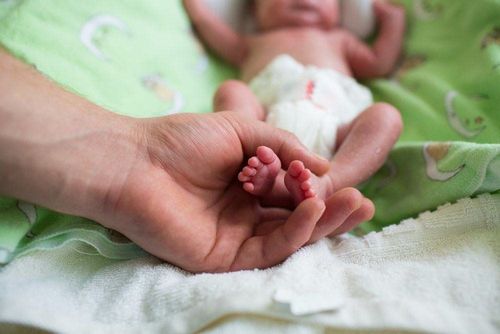This is an automatically translated article.
The article is professionally consulted by Master, Doctor Nguyen Thi An - Pediatrician - Neonatologist - Department of Pediatrics - Neonatology - Vinmec Ha Long International General Hospital.For children with pathological jaundice, they should be taken to a pediatric hospital soon for examination and treatment. The severe form of the disease cannot be ignored because if left untreated, it can cause serious complications, especially in the brain in jaundice.
1. What is neonatal jaundice?
Jaundice in newborns 2-3 days after birth is quite common. Mostly in premature babies, about 30% in babies full 40 weeks of gestation. Physiological jaundice will clear up on its own in about 2 weeks, while pathological jaundice needs to be treated by a doctor.If physiological jaundice usually appears from the 2nd to 4th day after birth and resolves within 10 days, then pathological jaundice needs long-term treatment with many different methods depending on the severity of the disease.
There are 4 main factors that cause premature jaundice in newborns that can lead to dangerous complications, which are:
Preterm birth: Babies born before 36 weeks have a high risk of physiological jaundice due to the liver's inability to process bilirubin as quickly as a full-term infant. Bruising during delivery: During labor and natural birth or also a cesarean section some babies get bruises on their body that is also a factor in premature jaundice. Blood Type: Jaundice due to blood group incompatibility usually occurs when the baby has blood type A or B, while the mother has blood type O. About 4% of babies with ABO blood group incompatibility jaundice require a blood transfusion. . Another rare case is when the mother has Rh (-) blood type while the baby has Rh (+) blood group. Jaundice due to Rh factor incompatibility is a serious case, the later the baby is born, the greater the danger. Breastfeeding: Breastfed babies have a higher risk of jaundice. However, the benefits that breast milk brings far outweigh the disadvantages that jaundice can cause, so experts still recommend that mothers should breastfeed from birth.
2. Manifestations of pathological jaundice
Different from the manifestations of physiological jaundice such as: Appears on the face, neck, chest and abdomen above the navel about 24 hours after birth, disappears within 1 week for full-term babies and 2 weeks for premature babies. than. At this level, the baby is still growing well and gaining weight evenly. Jaundice in newborns is considered pathological when there are the following abnormalities:Dark jaundice appears early Does not go away after 1 week for full-term infants and 2 weeks for preterm infants Degree of generalized jaundice and eyes Jaundice combined with other unusual symptoms such as vomiting, fever, crying a lot... Bilirubin blood test is higher than normal.

Biểu hiện vàng da bệnh lý dễ dàng được phát hiện bằng mắt thường
3. What is the complication of cerebral nuclei jaundice?
For children with pathological jaundice, they should be taken to a pediatric hospital soon for examination and treatment. Severe form of the disease cannot be ignored because if left untreated, it can cause serious complications.Acute cerebral bilirubin: If the mother detects that the child has jaundice with other signs such as lethargy, inattentiveness, crying a lot, skipping feeding, it may have a high fever, she should immediately think of acute cerebral bilirubin. According to doctors, Bilirubin is very toxic to the cells of the brain. Severe jaundice has the potential for Bilirubin to get into the brain and cause serious complications.
Jaundice of the brain nucleus: When the substance Bilirubin exceeds the allowable limit, the liver cannot eliminate it in time, there is a risk of seeping into the brain, ie the child has nuclear jaundice. This causes irreversible brain damage. Therefore, if pathological jaundice is identified, it must be treated before 7 days after birth to prevent brain damage.

Vàng da nhân não là gì?
4. Advice for moms
Monitor babies within 7 days after birth to detect early pathological jaundice, treat promptly:Physiological jaundice turns to pathological jaundice very fragile and often difficult to recognize because many babies do not have any signs Indicators such as: Excited, restless or lethargic, stopped sucking but sometimes the baby still suckles, moves and sleeps normally. When clinical signs appear, typically increased muscle tone, respiratory disorders, convulsions, lethargy or crying, it is already very severe. Even then, even if it can be treated, it will still leave very serious sequelae.
Children with pathological neonatal jaundice, if not treated promptly, within the first 7 days of life, bilirubin will cross the blood-brain barrier, causing nuclei of the brain syndrome, leaving many neurological sequels. Severe and irreversible, such as: Deafness, retardation of motor and intellectual development.

Theo dõi trẻ trong vòng 7 ngày sau sinh để phát hiện vàng da
Although dangerous, monitoring and detecting signs of pathological jaundice is not too difficult if mothers know the following simple skills: Focus on closely monitoring the baby in the first 7 days for all babies premature or normal birth. Evaluation of neonatal jaundice under natural light (sunlight). Should not be observed under neon or normal lights because it will not be clear whether the child has jaundice or not; Use your index finger to gently press on the hard bone base (forehead, cheekbones, chest, backs of hands, legs, feet) from the surface of the skin, hold for a few seconds, then observe the yellowness of the skin in the area that has just been lightly pressed. finger down.
Should observe the baby's skin in order from top to bottom: Starting from forehead - chest - abdomen - thighs - shins. If you only see jaundice from the forehead to the chest, there is no need for the child to go to the doctor, just monitor at home. If you see that the child has jaundice to the abdomen or to the thighs, legs, it is necessary to take the child to a pediatric facility with a neonatology department for immediate examination. Here, doctors will evaluate more deeply by clinical examination and quantitative test of bilirubin/blood. The "golden" time to effectively treat babies with jaundice is only in the first 7 days after birth with phototherapy or a combination of intravenous fluids. If left later than this time, the baby's skin is thicker and the light method will no longer be effective.
Pediatrics Department - Vinmec International General Hospital is the address for receiving and examining newborn diseases, including jaundice. At Vinmec, it is equipped with a safe and easy-to-implement lighting system, and babies can still breastfeed while having lights on. There are many types of projectors suitable for each jaundiced object that needs to be illuminated: crib-shaped lights (the child lies directly on top, double lights that project above and below (used in cases where positive light is required), blanket lamps , the bag is wrapped around the young person (very convenient for the mother when taking care of the baby: you can just pick it up to breastfeed and shine the light). Severe to late, with too high bilirubin in the blood, the doctor will prescribe the use of blood exchange as a last resort. Reducing bilirubin in the blood and thereby also reducing bilirubin outside the organization
As a key area of Vinmec Health system, Pediatrics Department always brings satisfaction to customers and is evaluated by industry experts With:
Gathering a team of leading pediatricians: including leading experts, with high professional qualifications (professor, associate professor, doctorate, master) , rich experience, worked at big hospitals like Bach Mai, 108.. The doctors are well-trained, professional, have a heart - reach, understand young psychology. In addition to domestic pediatric specialists, the Department of Pediatrics also has the participation of foreign experts (Japan, Singapore, Australia, USA) who are always pioneers in applying the latest and most effective treatment regimens. . Comprehensive services: In the field of Pediatrics, Vinmec provides a series of continuous medical examination and treatment services from Newborn to Pediatric and Vaccine,... according to international standards to help parents take care of their baby's health from birth to childhood. from birth to adulthood Specialized techniques: Vinmec has successfully deployed many specialized techniques to make the treatment of difficult diseases in Pediatrics more effective: neurosurgery - skull surgery, stem cell transplantation. blood in cancer treatment. Professional care: In addition to understanding children's psychology, Vinmec also pays special attention to the children's play space, helping them to have fun and get used to the hospital's environment, cooperate in treatment, improve the efficiency of medical treatment. Master. Doctor. Nguyen Thi An, former Head of Pediatrics Department, Quang Ninh General Hospital, is a person who is very passionate about health care for children and successfully treats many difficult cases. Currently, is a Doctor of Pediatrics - Neonatology - Department of Neonatology at Vinmec Ha Long International Hospital.
Please dial HOTLINE for more information or register for an appointment HERE. Download MyVinmec app to make appointments faster and to manage your bookings easily.













